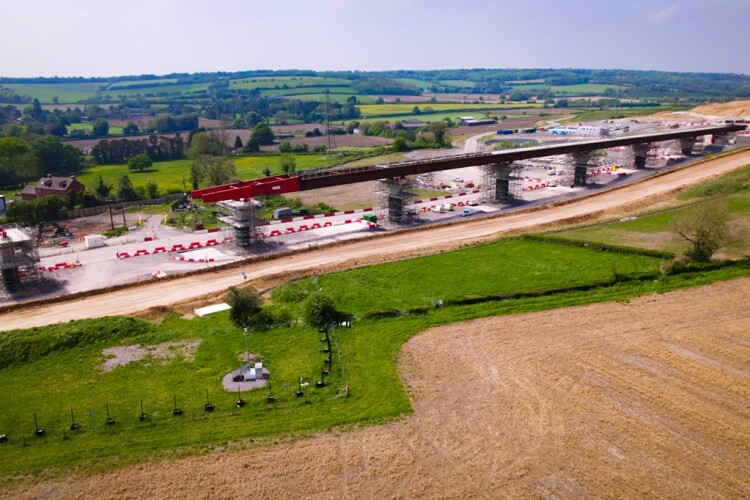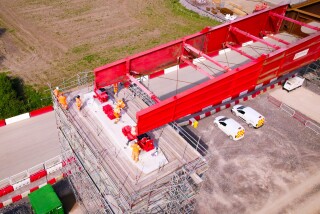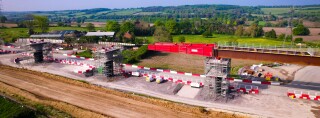Over a 20 hour period last week, HS2 contractor EKFB managed the sliding of a 3,130-tonne structure, high above Buckinghamshire's Misbourne Valley.
Using Teflon pads to reduce friction, the deck was moved 270-metres towards its final position
The deck of the Wendover Dean Viaduct – which will eventually stretch for 450 metres – is being assembled in three stages, ranging from 90-metre to 180-metre sections, with each one pushed out from the north abutment before the next section is attached behind it.
This process means that the weight of the deck increases with each push, up from an initial 590 tonnes at the start of work in January to 3,700 tonnes by the end of the year.
At this point in the Chilterns, the railway will be on a slight gradient, so to help maintain control, the deck is being pushed slightly uphill, with the finish point approximately 1.8 metres higher than start point.
HS2 Ltd senior project manager Ben Sebastian-Green said: “It’s great to see so much progress at Wendover Dean Viaduct over the last few days – with all the piers and the first three slides now done. The narrow site has always made it a challenging place to build, but I’m really impressed by how everyone’s pulled together to get us where we are today.
“Once complete, the viaduct will form a crucial part of the HS2 project - carrying fast trains between London and Birmingham and freeing up space on the existing mainline for more local and freight services.”
The Wendover Dean Viaduct is the first major railway bridge in the UK to be built with a double composite structure, which uses less concrete and steel than a more traditional design. Instead of using solid pre-stressed concrete beams to form the spans between the viaduct piers, the hollow double composite structure uses two steel beams sandwiched between two layers of reinforced concrete to create a more efficient span. A similar approach will also be used for HS2's Small Dean, Westbury, Lower Thorpe and Turweston viaducts.

All five viaducts are being built by HS2 Ltd’s main works contractor, EKFB – a joint venture of Eiffage, Kier, Ferrovial Construction and Bam Nuttall – with the manufacture and installation of the beams led by specialists at Eiffage Metal.
EKFB worked with its design partner ASC (a joint venture between Arcadis, Setec and Cowi) and architect Moxon on the double composite approach, which was inspired by structures on the French and other high-speed networks.
The approach is set to cut the carbon footprint of the structure by around half, it is claimed, and help HS2 achieve its goal of halving the amount of embedded carbon in construction.
The beams are made of ‘weathering steel’, which naturally fades to a dark brown colour over time and will help match the natural tone of the surrounding countryside. Weathering steel gets its characteristic colour from a surface layer of corrosion thatprotects the steel and removes the need for regular painting.
The Wendover Dean Viaduct will be supported by nine evenly spaced piers, some of which are up to 14 metres high and all of which are now complete. These were formed from a series of hollow pre-cast concrete shells – manufactured in Northern Ireland – which were placed on top of each other and filled with concrete and steel reinforcing.
This approach was chosen "to enable a crisp, clean external finish to the concrete, cut the amount of work on site and reduce disruption for local residents", HS2 says.
The last few months has also seen progress at HS2’s other major viaducts, with the first sections of the approach viaducts for Birmingham Curzon Street station completed and the first beams installed at the Delta Junction in North Warwickshire.
Got a story? Email news@theconstructionindex.co.uk





